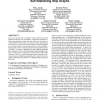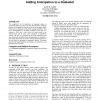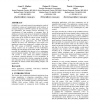209 search results - page 27 / 42 » The Computational Complexity of Weak Saddles |
PODC
2009
ACM
14 years 8 months ago
2009
ACM
Peer-to-peer systems rely on scalable overlay networks that enable efficient routing between its members. Hypercubic topologies facilitate such operations while each node only nee...
RECOMB
2008
Springer
14 years 7 months ago
2008
Springer
We study the problem of transforming a multichromosomal genome into another using Double-Cut-and-Join (DCJ) operations. We introduce the notion of DCJ scenario that does not break ...
AGENTS
2001
Springer
14 years 14 hour ago
2001
Springer
The complexity of AI characters in computer games is continually improving; however they still fall short of human players. In this paper we describe an AI bot for the game Quake ...
SAC
2000
ACM
13 years 12 months ago
2000
ACM
DARWIN is a web-based system for presenting the results of wind-tunnel testing and computational model analyses to aerospace designers. DARWIN captures the data, maintains the inf...
EUROPAR
2010
Springer
13 years 8 months ago
2010
Springer
Ants provide an attractive metaphor for robots that "cooperate" in performing complex tasks. What, however, are the algorithmic consequences of following this metaphor? ...



